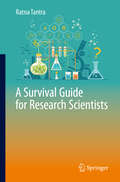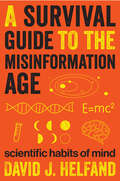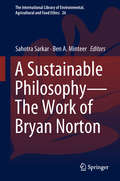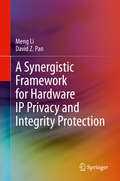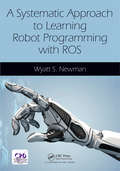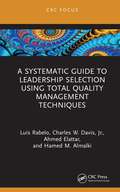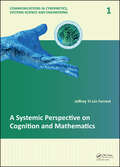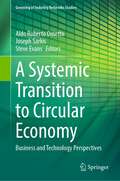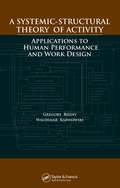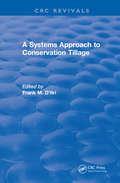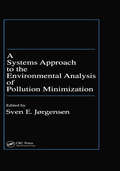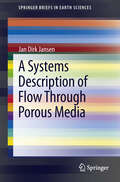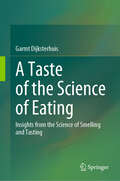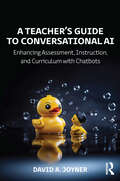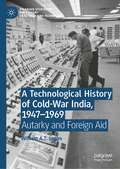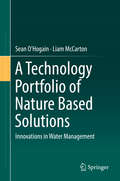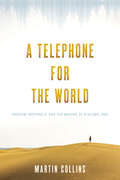- Table View
- List View
A Survival Guide for Research Scientists
by Ratna TantraResearch scientists play a pivotal role in society. Their passion for science will drive them forward, leading to new discoveries that will ultimately make the world a better place. Unfortunately, as the professional environment becomes more and more competitive, research scientists today cannot just rely on technical knowledge to carve successful careers. Besides technical skills, they will need to acquire other skills, such as how to communicate their science to the outside world. A Survival Guide for Research Scientists is a one-stop-shop that will help you to develop those core skills not often taught at school or university. The book has been written by an author with more than 20 years of scientific research experience (across different scientific disciplines). She has not only been a research scientist but also a writer, a consultant, a sole-trader and a project manager. A Survival Guide for Research Scientists takes on a holistic approach in order to help you pave the way for success. As such, it features practical guidelines on how to: • conduct your scientific research (how to: do literature review, design experiments, adopt best practice, ensure health and safety, etc.).• write and edit (reports, bid proposals, peer review publications, etc).• interact with the outside world (be a team leader, manage a project, network, deal with difficult people, do presentations, organise meetings, etc.).• look after your career (and get your dream job). • look after yourself (and how to manage stress). • look for a job (develop your CV, prepare for interviews, etc.). • become self-employed (and achieve business success). • deal with redundancy (and move forward in life, etc) Whatever your scientific background may be, this book is the perfect accompaniment, to guide you at every stage of your career.
A Survival Guide to the Misinformation Age: Scientific Habits of Mind
by David HelfandWe live in the Information Age, with billions of bytes of data just two swipes away. Yet how much of this is mis- or even disinformation? A lot of it is, and your search engine can't tell the difference. As a result, an avalanche of misinformation threatens to overwhelm the discourse we so desperately need to address complex social problems such as climate change, the food and water crises, biodiversity collapse, and emerging threats to public health. This book provides an inoculation against the misinformation epidemic by cultivating scientific habits of mind. Anyone can do it—indeed, everyone must do it if our species is to survive on this crowded and finite planet.This survival guide supplies an essential set of apps for the prefrontal cortex while making science both accessible and entertaining. It will dissolve your fear of numbers, demystify graphs, and elucidate the key concepts of probability, all while celebrating the precise use of language and logic. David Helfand, one of our nation's leading astronomers and science educators, has taught scientific habits of mind to generations in the classroom, where he continues to wage a provocative battle against sloppy thinking and the encroachment of misinformation.
A Survival Guide to the Misinformation Age: Scientific Habits of Mind
by David J. HelfandLearning how to tell news from fake news from fake fake news: An &“important and timely&” book on protecting ourselves, and society, from the infodemic (Library Journal). We have billions of bytes of data at our fingertips. But how much of it is misinformation—or even disinformation? A lot of it is, and your search engine can&’t tell the difference. As a result, an avalanche of misinformation threatens to overwhelm the discourse we so desperately need to address complex social problems such as climate change, the food and water crises, biodiversity collapse, and emerging threats to public health. This book provides an inoculation against the misinformation epidemic by cultivating scientific habits of mind. Anyone can do it—indeed, everyone must do it if our species is to survive on this crowded and finite planet. This survival guide supplies an essential set of apps for the prefrontal cortex while making science both accessible and entertaining. It will dissolve your fear of numbers, demystify graphs, and elucidate the key concepts of probability, all while celebrating the precise use of language and logic. David Helfand, one of our nation&’s leading astronomers and science educators, has taught scientific habits of mind to generations in the classroom, where he continues to wage a provocative battle against sloppy thinking and the encroachment of misinformation. &“Provides a vital antidote to the ills of misinformation by teaching systematic and rigorous scientific reasoning.&” —The Times Literary Supplement
A Sustainability Challenge
by Committee on Food Security for All as a Sustainability ChallengeThe National Research Council's Science and Technology for Sustainability Program hosted two workshops in 2011 addressing the sustainability challenges associated with food security for all. The first workshop, Measuring Food Insecurity and Assessing the Sustainability of Global Food Systems, explored the availability and quality of commonly used indicators for food security and malnutrition; poverty; and natural resources and agricultural productivity. It was organized around the three broad dimensions of sustainable food security: (1) availability, (2) access, and (3) utilization. The workshop reviewed the existing data to encourage action and identify knowledge gaps. The second workshop, Exploring Sustainable Solutions for Increasing Global Food Supplies, focused specifically on assuring the availability of adequate food supplies. How can food production be increased to meet the needs of a population expected to reach over 9 billion by 2050? Workshop objectives included identifying the major challenges and opportunities associated with achieving sustainable food security and identifying needed policy, science, and governance interventions. Workshop participants discussed long term natural resource constraints, specifically water, land and forests, soils, biodiversity and fisheries. They also examined the role of knowledge, technology, modern production practices, and infrastructure in supporting expanded agricultural production and the significant risks to future productivity posed by climate change. This is a report of two workshops.
A Sustainable Green Future: Perspectives on Energy, Economy, Industry, Cities and Environment
by Suphi S. OncelThe aim of this book is to open a vision to sustainability and development through a holistic perspective comprising the critical blocks of energy, environment and economy. From renewable energy, urban infrastructure, societal health to industrial symbiosis, the book assesses critical issues to reach a green future with realistic solutions proposed by a diverse range of multidisciplinary experts. It is intended for a broad readership of academics, researchers and industry experts focusing on these fields, and with specializations in sustainability. The book is divided into different clusters starting with an introductory foreword to express the theme of the book and the route of the titles. The first cluster of the book highlights various multidisciplinary perspectives considering the interaction between different expertise. From engineering to economy supported with social pillars, this section gives the critical points of selected topics to focus on the future with a sustainability vision. The second cluster focuses on health issues, with discussion about the impacts of the COVID-19 pandemic and the way forward. Critical points like vaccines, health care and food security are highlighted. The third cluster is comprised of titles related to the urban environment and infrastructure. New solutions and discussions on biodesign, waste management and transportation are covered in this section. The last cluster covers energy, and highlights renewable energies such as bioethanol, biogas and wind.
A Sustainable Philosophy—The Work of Bryan Norton (The International Library of Environmental, Agricultural and Food Ethics #26)
by Ben A. Minteer Sahotra SarkarThis book provides a richly interdisciplinary assessment of the thought and work of Bryan Norton, one of most innovative and influential environmental philosophers of the past thirty years. In landmark works such as Toward Unity Among Environmentalists and Sustainability: A Philosophy of Adaptive Ecosystem Management, Norton charted a new and highly productive course for an applied environmental philosophy, one fully engaged with the natural and social sciences as well as the management professions. A Sustainable Philosophy gathers together a distinguished group of scholars and professionals from a wide array of fields (including environmental philosophy, natural resource management, environmental economics, law, and public policy) to engage Norton’s work and its legacy for our shared environmental future. A study in the power of intellectual legacy and the real-world influence of philosophy, the book will be of great interest scholars and students in environmental philosophy, public policy and management, and environmental and sustainability studies. By considering the value and impact of Norton’s body of work it will also chart a course for the next generation of pragmatic environmental philosophers and sustainability scholars grappling with questions of environmental value, knowledge, and practice in a rapidly changing world.
A Synergistic Framework for Hardware IP Privacy and Integrity Protection
by Meng Li David Z. PanThis book proposes a synergistic framework to help IP vendors to protect hardware IP privacy and integrity from design, optimization, and evaluation perspectives. The proposed framework consists of five interacting components that directly target at the primary IP violations. All the five algorithms are developed based on rigorous mathematical modeling for primary IP violations and focus on different stages of IC design, which can be combined to provide a formal security guarantee.
A Systematic Approach to Learning Robot Programming with ROS
by Wyatt Newman<p>A Systematic Approach to Learning Robot Programming with ROS provides a comprehensive, introduction to the essential components of ROS through detailed explanations of simple code examples along with the corresponding theory of operation. The book explores the organization of ROS, how to understand ROS packages, how to use ROS tools, how to incorporate existing ROS packages into new applications, and how to develop new packages for robotics and automation. It also facilitates continuing education by preparing the reader to better understand the existing on-line documentation. <p>The book is organized into six parts. It begins with an introduction to ROS foundations, including writing ROS nodes and ROS tools. Messages, Classes, and Servers are also covered. The second part of the book features simulation and visualization with ROS, including coordinate transforms. <p>The next part of the book discusses perceptual processing in ROS. It includes coverage of using cameras in ROS, depth imaging and point clouds, and point cloud processing. Mobile robot control and navigation in ROS is featured in the fourth part of the book <p>The fifth section of the book contains coverage of robot arms in ROS. This section explores robot arm kinematics, arm motion planning, arm control with the Baxter Simulator, and an object-grabber package. The last part of the book focuses on system integration and higher-level control, including perception-based and mobile manipulation. <p>This accessible text includes examples throughout and C++ code examples are also provided at https://github.com/wsnewman/learning_ros</p>
A Systematic Guide to Leadership Selection Using Total Quality Management Techniques
by Luis Rabelo Charles W. Davis, Jr. Ahmed Elattar Hamed M. AlmalkiThe old cliché states that not every manager is a leader, but the more important part of that sentiment is that to be a good manager, one has to be a good leader. This perception is because good managers do more than manage. They have to lead by inspiration, they have to lead by example, and they have to lead through the best times for their organizations as well as the absolute worst times. A Systematic Guide to Leadership Selection Using Total Quality Management Techniques identifies the application gap and presents a methodology based on Total Quality Management (TQM) to support the guidance of a process to select leadership (at any level of the organization). A modification to the House of Quality and a product of the Massachusetts Institute of Technology is presented and discussed as the core of a leader selection process. Two case studies are used to reinforce the concepts and applications. Finally, the book introduces some experiments for leadership development using virtual worlds and ends with a note for the future using the metaverse and digital twins for leadership. The book is intended for professionals and executives wanting to learn more about leader selection, engineering and business students, directors of human resources, and researchers in the field of leadership.
A Systemic Perspective on Cognition and Mathematics (Communications in Cybernetics, Systems Science and Engineering)
by Jeffrey Yi-Lin ForrestThis book is devoted to the study of human thought, its systemic structure, and the historical development of mathematics both as a product of thought and as a fascinating case analysis. After demonstrating that systems research constitutes the second dimension of modern science, the monograph discusses the yoyo model, a recent ground-breaking deve
A Systemic Transition to Circular Economy: Business and Technology Perspectives (Greening of Industry Networks Studies #12)
by Steve Evans Joseph Sarkis Aldo Roberto OmettoThe book will explore, using multiple perspectives from multiple contributors, two main aspects for circular economy (CE) business and technology (B&T): systems and value perspectives. Going beyond a linear-economic perspective--the traditional perspective--CE needs to develop intentional and integrated paths to help restore physical resources and regenerate the functions of natural and anthropic systems, creating greater economic and social opportunities, with environmentally positive outcomes. Whether this is feasible and possible within the context of CE and B&T is something that will be central to the contributions made in this book. A major objective of the book is to deliver practical and fundamental knowledge of B&T CE insights combining a systems perspective and value creation for socio-technical innovation leading to sustainable transitions and effective transformations. Based on those key aspects, the book is structured in two parts, one from a more theoretical and conceptual basis in Part 1, and a more applied perspective in Part 2. The chapters in Part 1 are presented through the lens of business and systems transitions. In Part 2, the chapters present the opportunities and the journeys from real case studies of companies engaged in circular business strategies, processes, practices, and technologies.
A Systemic-Structural Theory of Activity: Applications to Human Performance and Work Design
by Waldemar Karwowski Gregory BednyWhile its importance is widely recognized, the theoretical basis and practical applications of Activity Theory have not yet been firmly established in the field of human factors and ergonomics, experimental, and work psychology. This book presents the foundations of the systemic-structural theory of human activity. It contains multiple practical examples of systemic-structural theory of activity analyses, including a study of production operations in the manufacturing environment, system safety evaluation, work improvement, equipment design, robot system performance, and design of human/computer interaction tasks in the context of training, efficiency, work motivation, fatigue, personality, and individual style of performance.
A Systems Approach to Agroecology
by Pablo TittonellAs agroecology gains momentum in the international research-for-development arena, there is an urgent need for methods and tools to support the codesign and evaluation of agroecological systems and their transitions. The social and ecological complexity of agroecosystems, their dynamics, uncertainties and sustainability, calls for a holistic, systemic approach to agroecology. As such, several questions arise for example: how do we deal with heterogeneity, landscapes, biodiversity or learning processes in agroecosystems analysis? How do we categorise diversity or analyse trade-offs in social-ecological interactions? How do we conceptualise, codesign and monitor agroecological transitions? This book sets out to answer these questions by building on the valuable ‘classics’ in agroecology. The book presents a systems perspective that underpins a combination of methodologies, ranging from participatory tools and field observations to mathematical simulation modelling. Researchers, advanced students and transdisciplinary practitioners will find in this book insights and methods to design research and (co-) innovation processes to foster agroecological transitions.
A Systems Approach to Conservation Tillage
by Frank M. D'ItriThis book describes concepts, value judgments and background information on the expanding conservation tillage practices in the United States and provides a technical appraisal of the state of the art. Still, much remains to be learned about the agronomic, agricultural engineering and environmental parameters; and it is hoped that the inormation herein presented will stimulate further research toward a more integrated apporach to conversation tillage practices.
A Systems Approach to the Environmental Analysis of Pollution Minimization
by Sven E. JorgensenThe environmental analysis of pollution problems always involves the use of mass and energy balances to quantify the extent of pollution and its sources. This same form of analysis can be applied to ecosystems, production systems, a whole country or a region. A Systems Approach to the Environmental Analysis of Pollution Minimization identifies and describes the common factors shared by these systems.The book is organized in twelve chapters and progresses from general concepts to specific assessment methods. Chapter one is a general introduction to environmental management principles. Chapter two discusses conservation principles and their applications to environmental health. Chapters three and four explore ecosystem health, properties and analysis. Chapters five through eleven present different methods of analysis including Green Accounting, Clean Technology, Life Cycle Analysis, and Risk Assessment. Editor Sven Jorgensen closes the book with a sweeping summary. Jorgensen is a internationally published authority on the use and analysis of ecosystem models. His new book is a comprehensive guide for both students and professionals. A Systems Approach to the Environmental Analysis of Pollution Minimization is an invaluable contribution.Features
A Systems Description of Flow Through Porous Media (SpringerBriefs in Earth Sciences)
by Jan Dirk JansenThis text forms part of material taught during a course in advanced reservoir simulation at Delft University of Technology over the past 10 years. The contents have also been presented at various short courses for industrial and academic researchers interested in background knowledge needed to perform research in the area of closed-loop reservoir management, also known as smart fields, related to e.g. model-based production optimization, data assimilation (or history matching), model reduction, or upscaling techniques. Each of these topics has connections to system-theoretical concepts. The introductory part of the course, i.e. the systems description of flow through porous media, forms the topic of this brief monograph. The main objective is to present the classic reservoir simulation equations in a notation that facilitates the use of concepts from the systems-and-control literature. Although the theory is limited to the relatively simple situation of horizontal two-phase (oil-water) flow, it covers several typical aspects of porous-media flow. The first chapter gives a brief review of the basic equations to represent single-phase and two-phase flow. It discusses the governing partial-differential equations, their physical interpretation, spatial discretization with finite differences, and the treatment of wells. It contains well-known theory and is primarily meant to form a basis for the next chapter where the equations will be reformulated in terms of systems-and-control notation.The second chapter develops representations in state-space notation of the porous-media flow equations. The systematic use of matrix partitioning to describe the different types of inputs leads to a description in terms of nonlinear ordinary-differential and algebraic equations with (state-dependent) system, input, output and direct-throughput matrices. Other topics include generalized state-space representations, linearization, elimination of prescribed pressures, the tracing of stream lines, lift tables, computational aspects, and the derivation of an energy balance for porous-media flow. The third chapter first treats the analytical solution of linear systems of ordinary differential equations for single-phase flow. Next it moves on to the numerical solution of the two-phase flow equations, covering various aspects like implicit, explicit or mixed (IMPES) time discretizations and associated stability issues, Newton-Raphson iteration, streamline simulation, automatic time-stepping, and other computational aspects. The chapter concludes with simple numerical examples to illustrate these and other aspects such as mobility effects, well-constraint switching, time-stepping statistics, and system-energy accounting. The contents of this brief should be of value to students and researchers interested in the application of systems-and-control concepts to oil and gas reservoir simulation and other applications of subsurface flow simulation such as CO2 storage, geothermal energy, or groundwater remediation.
A Systems Perspective on Financial Systems (Communications in Cybernetics, Systems Science and Engineering)
by Jeffrey Yi-Lin ForrestThis book is devoted to a systems-theoretical presentation of the main results of applying the systemic yoyo model and relevant analytical tools to the topics of money and financial institutions. The author presents the main concepts and results of the subject matter in the language of systems science, which has in the past century prompted revolut
A Taste For Honey
by H F HeardMycroft has turned detective...A masterclass of classic crime - 'A triumph of ingenuity and horrific simplicity' Boris Karloff'A very clever thriller' Raymond ChandlerIn an English country village, a recluse and a beekeeper team up to catch a cunning villain.Far from the noise of Victorian London, Sydney Silchester's two passions are privacy and honey. But when his honey supplier is found stung to death by her hive, the search for a new beekeeper takes Sydney to Mr. Mycroft, a brilliant man who has retired to Sussex to take up precisely this occupation, and who shares many traits with the great detective, Sherlock Holmes. Mycroft, himself no stranger to crime-solving, immediately senses the bloody hand of murder. But what villain would have the mad intelligence to train an army of killer bees? And will Mycroft risk his own life to find the killer?
A Taste of the Science of Eating: Insights from the Science of Smelling and Tasting
by Garmt DijksterhuisWhy do you taste what you taste, and what about smelling? Many books address good food, but few go deeper, explaining the processes behind smelling and tasting. The book addresses the senses of smell and taste and the many more senses and their interactions during eating. It also stresses the importance of psychology when you smell, taste and eat. Some of the other topics include flavour, the working of the nose and olfactory (cross-)adaptation, the use of odorants, the relation between emotion and eating, and many more. The book helps you understand why you like and eat food, and shows the intriguing complexity of the area.
A Teacher's Guide to Using the Next Generation Science Standards with Gifted and Advanced Learners
by Cheryll Adams Alicia Cotabish Debbie DaileyA Teacher's Guide to Using the Next Generation Science Standards With Gifted and Advanced Learners provides teachers and administrators with practical examples of ways to build comprehensive, coherent, and rigorous science learning experiences for gifted and advanced students from kindergarten to high school. It provides an array of examples across the four domains of science: physical sciences; Earth and space sciences; life sciences; and engineering, technology, and applications of science. Each learning experience indicates the performance expectation addressed and includes a sequence of activities, implementation examples, connections to the CCSS-Math and CCSS-ELA, and formative assessments. Chapters on specific instructional and management strategies, assessment, and professional development suggestions for implementing the standards within the classroom will be helpful for both teachers and administrators.
A Teacher’s Guide to Conversational AI: Enhancing Assessment, Instruction, and Curriculum with Chatbots
by David A. JoynerA Teacher’s Guide to Conversational AI explores the practical role that language-based artificial intelligence tools play in classroom teaching, learning experiences, and student assessment. Today’s educators are well aware that conversational and generative AI—chatbots, intelligent tutoring systems, large language models, and more—represent a complex new factor in teaching and learning. This introductory primer offers comprehensive, novice-friendly guidance into the challenges and opportunities of incorporating AI into K-12 schools and college classes in ways that are appropriate, nourishing to students, and outcomes-driven.Opening with an informative overview of the foundational properties, key terminology, and ethical considerations of these tools, the book offers a coherent and realistic vision of classrooms that are enhanced, rather than stymied, by AI systems. This includes strategies for:· designing assessments that are conducive to students’ beneficial use of AI while mitigating overreliance or dishonesty;· using AI to generate lesson examples for student critique or custom content that reinforces course principles;· leveraging chatbots as a co-instructor or a tutor, a guide during student-driven learning, a virtual debate or brainstorming partner, and a design project; and· creating course content, lesson plans and activities, expanded language and accessibility options, and beyond. Through the depth of understanding and applied approach provided in these chapters, teachers and leaders in training and in service, alongside private tutors, college instructors, and other educators, will be better prepared to future-proof their efforts to serve new generations of learners.
A Technological History of Cold-War India, 1947–1969: Autarky and Foreign Aid (Palgrave Studies in the History of Science and Technology)
by William A.T. LoganThis book provides a technological history of modern India, in particular the Nehruvian development in the context of the Cold War. Through a series of case studies about military modernization, transportation infrastructure, and electric power, it examines how the ideals of autarky and technological indigenization conflicted with the economic and political realities of the Cold War world. Where other studies tend to focus on the political leaders and economists who oversaw development, this book demonstrates how the perspective of the engineers, government bureaucrats, and aid workers informed and ultimately implemented development.
A Technology Portfolio of Nature Based Solutions: Innovations In Water Management
by Sean O'Hogain Liam McCartonThis book aims to define the concept of Nature Based Solutions (NBS) by using case studies from members of the European Innovation Partnership (EIP) Water Action Group - NatureWat. NBS is defined and characterized in terms of water source, contaminants, removal mechanisms and resource recovery potential. The case studies presented illustrate the appropriateness of NBS promoting climate resilience. Readers will discover a technology portfolio based on a number of demonstration sites in the fields of climate change adaption, water and wastewater treatment, resource recovery and re-use, and restoring ecosystems to promote the use of nature based solutions. The chapters in the book present a multidisciplinary approach involving social scientists, governance representatives and engineers. The underlying philosophy of the book is the circular economy of water which prioritizes the concepts of resource recovery and resilience within water resource management. The first section of the book presents the background and objectives of the study, and how the action group aims to promote the use of nature based solutions through its diverse technology portfolio. Particular attention is given to the goals of finding cost-effective solutions for wastewater treatment, climate change mitigation, disaster risk reduction, flood protection, greening cities, degraded areas restoration and biodiversity preservation. The chapter on reclaimed water addresses water reuse and defines the term fit for purpose. Barriers and limitations related to NBS for water resource management are discussed. The book concludes with several case studies at local, regional and global levels which illustrate a new approach to water management. These case studies illustrate the application of a hybrid green and grey infrastructure system. This is a combination of traditional engineered infrastructure with nature based solutions which combines centralised and decentralised systems to optimise the reclamation of water for reuse in a fit for purpose model.
A Telephone for the World: Iridium, Motorola, and the Making of a Global Age
by Martin CollinsIn a post–Cold War world, the Iridium satellite network revealed a new age of globalization.In June 1990, Motorola publicly announced an ambitious business venture called Iridium. The project’s signature feature was a constellation of 77 satellites in low-Earth orbit which served as the equivalent of cellular towers, connecting to mobile customers below using wireless hand-held phones. As one of the founding engineers noted, the constellation "bathed the planet in radiation," enabling a completely global communications system. Focusing on the Iridium venture, this book explores the story of globalization at a crucial period in US and international history. As the Cold War waned, corporations and nations reoriented toward a new global order in which markets, neoliberal ideology, and the ideal of a borderless world predominated. As a planetary-scale technological system, the project became emblematic of this shift and of the role of the United States as geopolitical superpower. In its ambition, scope, challenges, and organizing ideas, the rise of Iridium provides telling insight into how this new global condition stimulated a re-thinking of corporate practices—on the factory floor, in culture and knowledge, and in international relations.Combining oral history interviews with research in corporate records, Martin Collins opens up new angles on what global meant in the years just before and after the end of the Cold War. The first book to tell the story of Iridium in this context, A Telephone for the World is a fascinating look at how people, nations, and corporations across the world grappled in different ways with the meaning of a new historical era.
A Test of the General Validity of the Heckscher-Ohlin Theorem for Trade in the European Community
by Dalia HakuraA report from the International Monetary Fund.
